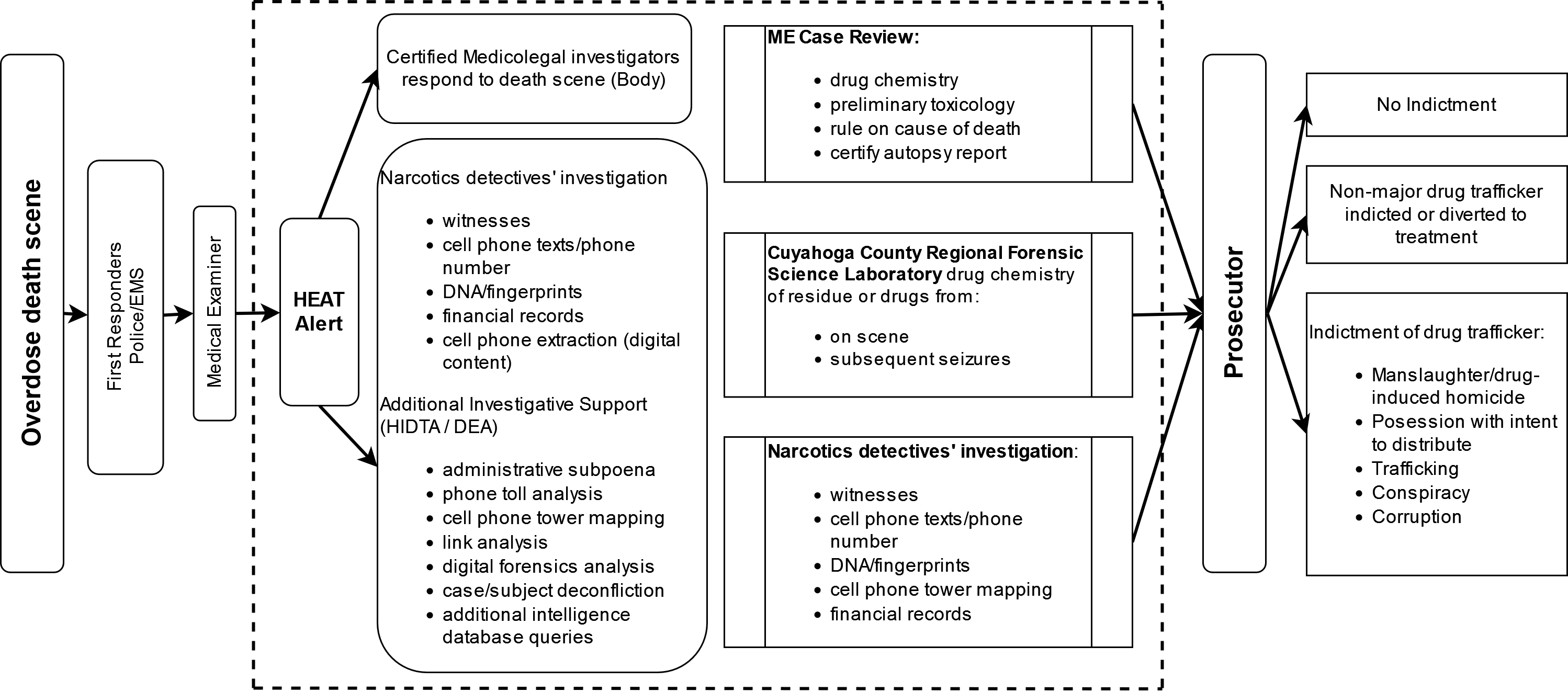
Combating drug trafficking and preventing overdose deaths is one of the primary objectives of the department’s 2022-2026 strategic plan.[1] In 2021, the United States recorded the highest number of deaths resulting from drug overdoses over a 12-month period. Synthetic opioids, including illicit fentanyl, were involved in 66-percent of these overdose deaths.[2]
Cuyahoga County’s Medical Examiner’s Office developed the Heroin Involved Death Investigation (HIDI) Protocol to support a safe, coordinated, and rapid response to active drug overdose death scenes. Per the protocol, alerts are sent to law enforcement investigators if the medical examiner suspects a death is related to opioid use or overdose. These alerts notify law enforcement of potential dangers (e.g., lethal drugs) and facilitate protection of the scene and collection of evidence. Potential benefits of the HIDI Protocol include:
Although it was originally developed to respond to fatal overdose incidents, HIDI alerts also support responses to non-fatal scenes. In these cases, information gathered may inform investigations and prosecutions.

Researchers at Case Western Reserve University Begun Center for Violence Prevention Research and Education received funding from NIJ to examine the HIDI Protocol and suggest possible improvements based on interviews with practitioner stakeholders. This research was conducted in collaboration with the Cuyahoga County Medical Examiner, the Cleveland Division of Police, the U.S. Attorney for the Northern District of Ohio, and the Cuyahoga County Prosecutor’s Office. The researchers found:
The research goals were to:
The researchers coded medicolegal overdose death investigation files (n=3261) from 2014 through 2019 for toxicology, victim demographics and history, and scene evidence. They also examined public records on federal (n=43) and state (n=78) drug-induced homicide or manslaughter cases identified by prosecutors for charges, outcome, and evidence used. They conducted interviews and focus groups between April 2018 and September 2021 with 54 staff who developed the HIDI protocol or were affected by the HIDI interagency network; those included medical examiner medicolegal investigators and other medical examiner’s office staff, police overdose death investigators, federal and county prosecutors, and other key stakeholders.
Limitations in medical examiner data include the secondary nature of family or witness reports of medical or behavioral health histories or the circumstances of the overdose. In addition, only publicly available prosecution files could be used due to COVID-19-related access restrictions. Finally, Cuyahoga County is primarily urban, so the qualitative findings from this study may not be generalizable to rural and tribal areas.
Overall, this project examined the HIDI Protocol and found it to be an innovative, collaborative system of data protection, collection, and flow that supports overdose investigations. In addition, the researchers identified several opportunities for improvement. The research team concluded that, with slight modifications, the HIDI Protocol could be implemented in other communities experiencing similar opioid overdose-related challenges. However, applications to other jurisdictions would need to consider potential risks and harms to individuals or groups and ethical considerations that may factor into use of the protocol. In addition, users should be aware of all relevant statutes, regulations, and/or governing judicial decisions (e.g., established case law, prevailing court rulings) related to the protocol’s use.
The work described in this article was supported by NIJ grant 2017-DN-BX-0168 awarded Case Western Reserve University.
This article is based on the grantee report, “Cuyahoga County, Ohio, Heroin and Crime Initiative: Informing the Investigation and Prosecution of Heroin-Related Overdose” (2022) by Daniel J. Flannery, Ph.D., Mark Fleisher, Ph.D., Karen Flynn, Ph.D., Michelle Riske-Morris, J.D., Ph.D., and Sarah Fulton, M.A.
[note 1] U.S. Department of Justice (2022). FYs 2022-2026 Strategic Plan—U.S. Department of Justice, https://www.justice.gov/doj/book/file/1516901/download.
[note 3] The medical examiner’s fully certified autopsy report and verdict complete the documentation of this “but for causation,” listing the drug or combination of drugs that, without which, the person could have lived.